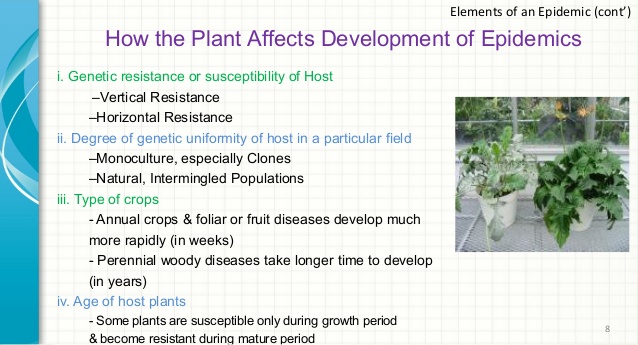
Host Factors that Affect Disease Epidemic
Host Factors That Affect The Development of An Epidemic
Several internal and external factors of particular host plants play an important role in the development of epidemics involving those hosts.
Levels of Genetic Resistance or Susceptibility of the Host
Obviously, host plants carrying race-specific (vertical) resistance do not allow a pathogen to become established in them, and thus no epidemic can develop. Host plants carrying partial (horizontal) resistance will probably become infected, but the rate at which the disease and the epidemic will develop depends on the level of resistance and the environmental conditions.
Susceptible host plants lacking genes for resistance against the pathogen provide the ideal substrate for establishment and development of new infections.
Therefore, in the presence of a virulent pathogen and a favorable environment, susceptible hosts favor the development of disease epidemics.
Degree of Genetic Uniformity of Host Plants
When genetically uniform host plants, particularly with regard to the genes associated with disease resistance, are grown over large areas, a greater likelihood exists that a new pathogen race will appear that can attack their genome and result in an epidemic. This phenomenon has been observed repeatedly, for example, in the Cochliobolus (Helminthosporium) blight on Victoria oats and in southern corn leaf blight on corn carrying Texas male-sterile cytoplasm. For similar reasons of genetic uniformity, the highest rates of epidemic development generally occur in vegetative propagated crops, intermediate rates in self-pollinated crops, and the lowest rates in cross-pollinated crops.
This explains why most epidemics develop rather slowly in natural populations, where plants of varying genetic makeup are intermingled.
Type of Crop
In diseases of annual crops, such as corn, vegetables, rice, and cotton, and in foliar, blossom, or fruit diseases of trees and vines, epidemics generally develop much more rapidly (usually in a few weeks) than they do in diseases of branches and stems of perennial woody crops such as fruit and forest trees. Some epidemics of fruit and forest trees, e.g., tristeza in citrus, pear decline, Dutch elm disease, and chestnut blight, take years to develop.
Age of Host Plants
Plants change in their reaction (susceptibility or resistance) to disease with age. The change of resistance with age is known as ontogenic resistance. In some plant–pathogen combinations, e.g., Pythium damping off and root rots, downy mildews, peach leaf curl, systemic smuts, rusts, bacterial blights, and viral infections, the hosts (or their parts) are susceptible only during the growth period and become resistant during the adult period (adult resistance). With several diseases, such as rusts and viral infections, plant parts are actually quite resistant to infection while still very young, become more susceptible later in their growth, and then become resistant again before they are fully expanded. In other diseases, such as infections of blossoms or fruit by Botrytis, Penicillium, Monilinia, and Glomerella, and in all postharvest infections, plant parts are resistant during growth and the early adult period but become susceptible near ripening. In still other diseases, such as potato late blight (caused by Phytopthora infestans) and tomato early blight (caused by Alternaria solani), a stage of juvenile susceptibility during the growth period of the plant is followed by a period of relative resistance in the early adult stage and then susceptibility after maturity.
Apparently then, depending on the particular plant–pathogen combination, the age of the host plant at the time of arrival of the pathogen may affect considerably the development of infection and of an epidemic.


